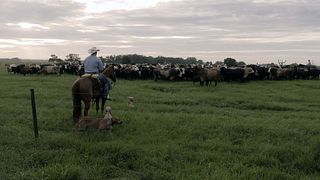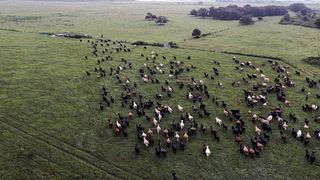Tera Barnhardt
“For me, making sure that these cattle are healthy and cared for is my number one priority when I get to the feedyard. And because I know the care that goes into raising beef, I feed it to my family because it’s delicious and helps them grow strong and healthy." - Tera Barnhardt
Animal Care is Number One Priority for Veterinarian Tera Barnhardt
Tera Barnhardt is the coordinator of animal health and welfare at Cattle Empire, a cattle feeding operation in southwest Kansas. She focuses on making sure animals are healthy and getting the feed and care they need. Tera and her husband, Sheldon have their hearts and hands full with their son, Archie, and daughter, Jolee. Keeping kids and cattle healthy and safe is a fulltime job for this veterinarian and mom.
"There is a lot of technology used at a feedyard to make everything work on a daily basis! It’s impressive that we have implemented so much technology to perform on a daily basis in the environmental challenges that come with raising cattle. As much technology as we are fortunate enough to utilize, there are still people who perform their work daily – wind, rain, shine or Christmas – to raise a safe, nutritious and delicious beef product for your family and ours."
"I'd like the public to know how much I care. When I am making decisions on a daily basis for the cattle that have been trusted in my care, I think about the consumer every time. I feed this beef to my kids, so I understand your concerns and interest in the process and I am excited to answer any questions you may have."
Meet Your Rancher:
Tell us a little bit about what do you do at Cattle Empire?
I am a veterinarian at a feedyard, so a large part of my job is designing protocols for animal health and welfare, training employees to carry them out and then designing benchmarking tools to make sure we are doing the very best we can. I work a lot with the animals, but I also spend a lot of time working with the people who help care for the animals daily.
How does Cattle Empire, and all feedyards, fit into the overall beef lifecycle and why are they so important to producing beef?
Feedyards function towards the end of the beef lifecycle. In the US, cattle are raised on pasture settings and will sometimes go to intermediate stockers or backgrounders. Cattle come to the feedyard and spend 4-6 months on feed in our care. This allows us to efficiently finish the cattle on a grain and hay based diet. It allows us to precisely provide the nutrients they need, administer care to animals that might become sick or injured, and monitor growth and production so that we can make sure we are always utilizing our resources to the best of our abilities.
What new innovations or technology at Cattle Empire are you excited about?
I am excited about any innovation or technology that allows us to preserve the current tools that we use to produce beef safely and efficiently. We have a responsibility to conserve resources and be stewards of the land, water, animal health products like vaccines, antibiotics and parasite control. I enjoy pushing the limit to research new technologies that allow us to preserve these resources.
What brought you into this profession?
I grew up in the agriculture industry and when I wanted to become a veterinarian, I knew I wanted to be involved in feedyard medicine. I was able to do a masters research project with Kansas feedyards while I was in graduate school and it was an amazing experience that got me hooked. Raising beef that is literally helping feed the world is noble work, I am proud to be a part of the puzzle!
What does your family mean to you and do they play in a role in your job?
I work at a large family-owned feedyard. We work for a family that employs other families to work in an industry that literally feeds other families. I am a millennial mom who is just trying to accomplish the same things that many other moms are – I want to raise good kids and I want them to be involved in agriculture so that they are fortunate enough to see exactly where their food comes from. I try to make decisions at my job that I would also make for my family because I know we have a huge responsibility to provide your family with safe and nutritious beef options for dinner!
Cattle Empire
Santana, KS
Feedyard
Cattle spend their final 4-6 months at a feedyard being fed a scientifically-balanced diet and receiving daily care.



